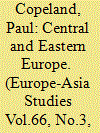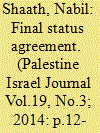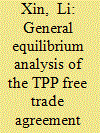| Srl | Item |
| 1 |
ID:
128993


|
|
|
|
|
| Publication |
2014.
|
| Summary/Abstract |
This article analyses the influence and status of the Central and Eastern European states within an enlarged European Union. It analyses two European Union policy negotiations: the Services Directive and the European Union's Financial Crisis Rescue Plan. Central to understanding the influence of a member state within negotiations are its economic size and knowledge of the Brussels policy-making apparatus. Nevertheless, as the new member states from Central and Eastern Europe have gained experience of the European Union policy negotiation process, they remain limited in their ability to influence outcomes. Therefore it can be concluded that while knowledge during negotiations is a necessary condition for successfully influencing outcome, alone it is insufficient because economic weight is particularly pertinent to those outcomes. As a result, the status of the new member states within the European Union is best described as being that of a junior partner, despite the assumed parity of Union membership.
|
|
|
|
|
|
|
|
|
|
|
|
|
|
|
|
| 2 |
ID:
129796


|
|
|
|
|
| Publication |
2014.
|
| Summary/Abstract |
The signing of the Oslo Accords created a tremendous sense of optimism. The Declaration of Principles signed between the Palestine Liberation Organization (PLO) and the Israeli government in 1993 led to many countries establishing diplomatic relations with Israel, a rise in Israel's GNP, and two productive economic conferences in Morocco and Jordan. One of the memories that best symbolizes this period for me occurred in May 1994: I had been invited to Washington by the president of the United States, and on the plane ride there, the whole cabin approached me with their menus asking me to autograph them. People were really excited, telling me: "This is peace! It's good for both parties." I felt their euphoria. It was a win-win game.
You cannot sign a peace treaty in a win-lose game, while devastating the other party. One only needs to look at what happened to the United States in Afghanistan and Iraq as examples. You don't really achieve a long-term solution with devastating wars. The only way you can build real peace is if it's a win-win situation: through negotiations, conversations and dialogues that lead to agreements which equally - or at least satisfactorily - satisfy both people. When it comes to our situation, I think it's not normal to talk now about permanence in these negotiations. Why? Because the interim agreement has continued for over 20 years. It is now 20 years since we signed the Declaration of Principles and the Oslo Agreement in the White House. So we have lived for 20 years in "interimness," and we have become accustomed to it. But "interimness" is not good for the Palestinians: While we've been in this seemingly never-ending interim time period, the Israeli government has been unilaterally changing the parameters, the terms of reference and the reality on the ground, thereby undermining the basis for a permanent solution.
|
|
|
|
|
|
|
|
|
|
|
|
|
|
|
|
| 3 |
ID:
130916


|
|
|
|
|
| Publication |
2014.
|
| Summary/Abstract |
The approaching tenth year of the Doha Round with no achievements to celebrate indicates a failure of the World Trade Organization. Formal negotiations of the Round expired in 2005 without reaching a consensus, and informal negotiations were stalled in 2008. Thus, the Trans-Pacific Partnership (TPP), a recent initiative to deepen trade relations among countries bordering the Pacific, was greeted with applause and relief as a step in the right direction. This article discusses the region-wide Free Trade Agreement series of linked agreements that cover various members and issues. The recursive dynamic computable general equilibrium (CGE) model simulates two scenarios against the baseline, namely, a TPP agreement with China and without China. The preliminary results show that the TPP agreement without China cannot change the significant roles of markets and geography as the principal factors behind the economic integration of Southeast Asia with China. Trade and investment agreements facilitate market forces, they do not oppose them. The integration of the Asia-Pacific countries may benefit the US and other key economies.
|
|
|
|
|
|
|
|
|
|
|
|
|
|
|
|